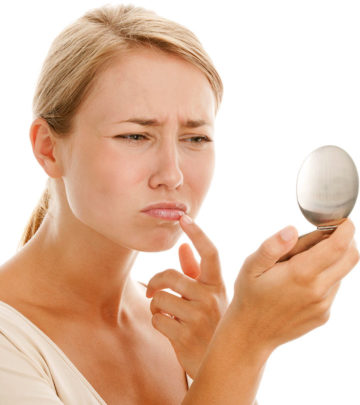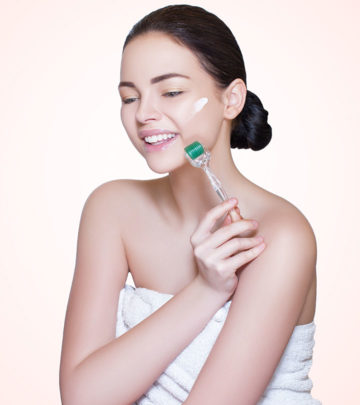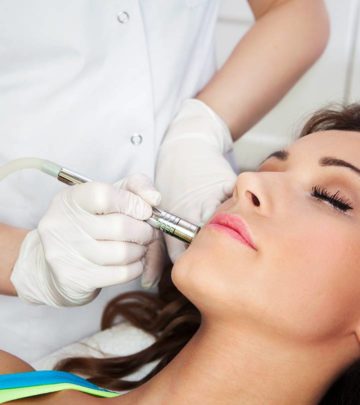UVA Vs. UVB Rays – What’s The Difference?

Image: Shutterstock
You know that you should wear sunscreen before you step out into the sun. But do you know why? Most of us have a faint idea of what UV rays can do to our skin. And most skin care woes start from not understanding the importance of protecting your skin from UV exposure. Unless you understand that, it’s tough to turn it into a skin care ritual. The best way to understand it is by understanding UV light and learning the difference between UVA and UVB rays.
Table Of Contents
What’s The Difference Between UVA And UVB Rays?
The sun emits radiation energy that reaches the earth as UV light or UV rays (UltraViolet rays). UV rays can be broken down into three types:
- UVA rays
- UVB rays
- UVC rays (don’t reach the earth’s surface)
Both UVA and UVB rays are invisible to the naked eye as they do not fall within the spectrum of visible light. Exposure to both the rays can cause immense damage to your skin and even lead to cancer (1). However, UVA and UVB rays affect and damage your skin in different ways.
Hence, it is important to understand the difference between them and learn about the need for broad-spectrum protection.
- UVA Rays – The Rays That Accelerate Skin Age
About 95% of the UV light that reaches the earth’s surface are UVA rays. There are a few things about UVA rays that make them dangerous for your skin:
- UVA rays have a longer wavelength (about 320 nm to 400 nm). There are two types of UVA rays – UVA1 (340nm to 400nm) and UVA2 rays (320nm to 340 nm).
- They can penetrate the deepest layers of your skin. They can cross the epidermis and reach your dermis.
- They are always present (even during cloudy days) and can get through any surface, especially glasses. So, you now know that those tinted glasses cannot save you (unless they are treated to filter UV rays)!
- Since they go deeper into the skin, they can damage the collagen and cause premature aging, fine lines, wrinkles, tanning.
- They damage every layer of your skin and affect its firmness and elasticity.
- These rays are a key trigger of every type of skin cancer. When the UVA rays reach your epidermis, they cause damage to the keratinocytes, which might cause cancer.
Since there’s a difference in the wavelengths of UVA rays, not all sunscreens work well in protecting your skin against them. That is the reason sunscreens now have multiple active ingredients to cover a broad spectrum. Some active ingredients like zinc oxide and titanium dioxide are used in most sunscreens and can protect your skin from the UVA rays (the entire spectrum). So, if the sunscreen is labeled “broad spectrum,” it means that it can protect you from the whole range of UVA rays.
- UVB Rays – The Rays That Burn Your Skin
These rays have more energy and are more intense than UVA rays. UVB rays are mostly responsible for:
- Sunburn
- Tanning
- Skin discoloration and pigmentation
And all the visible changes on your skin surface. UVB rays are something to worry about because:
- Like UVA rays, UVB rays are also present throughout the year. However, they are not that prevalent during cloudy days.
- UVB rays can only reach your epidermis. So, they cause the most damage to the upper layers of your skin (visible damage).
- UVB rays can be reflected from snow, sand, and water. Hence, you need to be careful when you go surfing or skiing.
- UVB rays are much stronger and damaging at higher altitudes. Always carry your sunscreen if you are going to the mountains.
Long-term exposure to both UVA and UVB rays increase the risk of skin cancer. While UVB rays leave you with visible damage, UVA rays damage your skin from within. Now that you are armed with the knowledge of UV rays, you need to understand how to protect your skin.
How To Protect Your Skin From UVA And UVB Rays
It’s simple – choose a sunscreen that’s labeled “broad-spectrum.” It means the sunscreen can protect you from both UVA and UVB rays. A few other tips include:
- Always choose a sunscreen that has at least SPF 30.
- Check for active ingredients like titanium dioxide and zinc oxide.
- Choose a water-resistant formula and reapply every 2 hours.
- Slathering sunscreen on your skin doesn’t mean you are fully protected. Take extra precaution by staying in the shade when the sun is at its peak (during the afternoon) and use sunglasses and hats.
- Limit your exposure to UV rays, particularly between 10 AM to 4 PM when the sun is the strongest.
- Wear clothes that cover your exposed parts. Wear long-sleeved clothes, long skirts, and long pants that will cover your skin. Also, dark colors protect your skin better than light colors. When choosing the fabric, be careful. Hold it against the light. If you can see the light through it, the UV rays can easily penetrate it.
- Avoid tanning beds. If you think they are harmless, that’s an illusion. Tanning lamps give out both UVA and UVB rays. If you want a tan, try tanning lotions instead.
Don’t let the sun get the better of you. All you need to do is use enough protection to prevent any skin issues. Take care of your skin and do not hesitate to seek medical attention if you develop any issues. Beautiful skin is not an overnight miracle – it requires a lot of care and commitment.
If you have any questions regarding this article, please post them in the comments box below.
Reference
1. “UV Radiation and the Skin”, International Journal of Molecular Sciences, US National Library of Medicine.
Recommended Articles:
Read full bio of Dr. Vindhya L Veerula
























